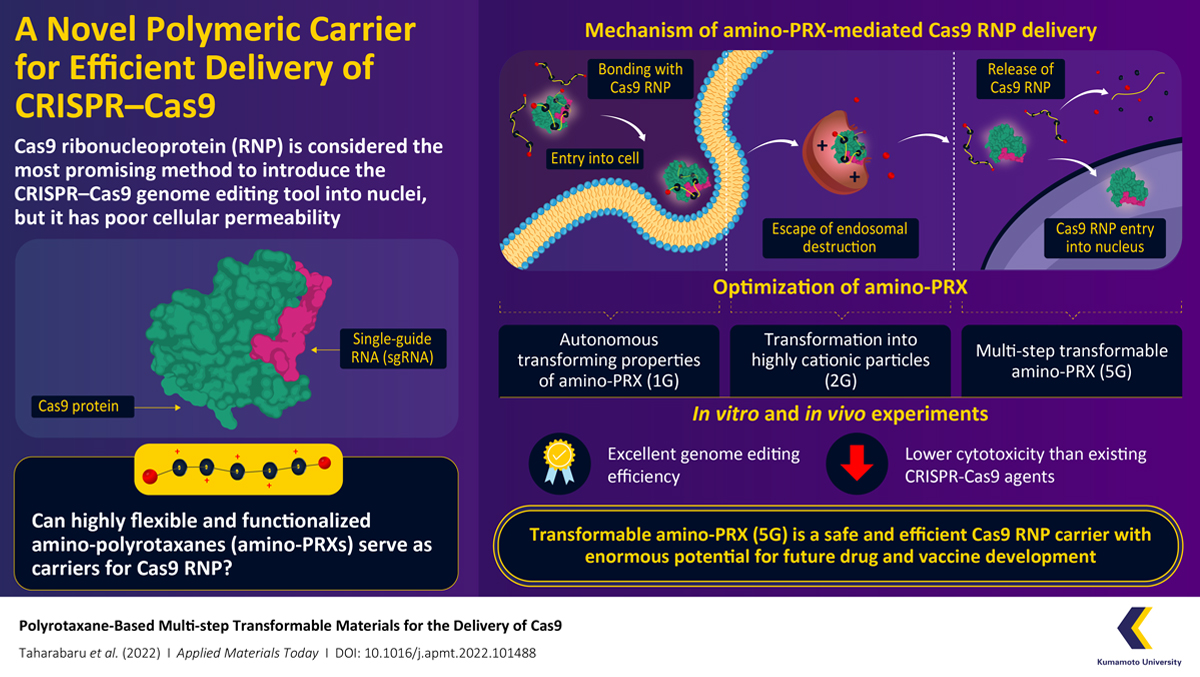
Supramolecular CRISPR-Cas9 Carrier Enables More Efficient Genome Editing
May 18, 2022| |
CRISPR-Cas9 is a game-changing genome editing system. The direct delivery of Cas9–sgRNA complexes, such as the Cas9 ribonucleoproteins (RNPs), into the cell nucleus, is considered the safest and most efficient way to achieve genome editing. However, the Cas9 RNP has poor cellular permeability and requires a carrier molecule to get to the cell nucleus. The carriers need to bind with Cas9 RNP, carry it into the cell, prevent its degradation by intracellular organelles called endosomes, and finally release it without causing any changes to its structure.
A research team from Kumamoto University has developed a transformable polyrotaxane (PRX) carrier that can facilitate genome editing using Cas9 RNP with high efficiency and usability. “Our findings describe how to precisely control intracellular dynamics across multiple steps. This will prove invaluable for future research in this direction,” says Professor Keiichi Motoyama, a corresponding author of the paper published in Applied Materials Today.
For their novel carrier, the researchers focused on PRX with amine groups and went through multiple rounds of development and optimization before their final product. The first-generation of their carrier molecules exploited the autonomous transforming properties of amino-PRX to efficiently complex it with Cas9 RNP and enable its delivery past the cell membrane. The second-generation worked towards the endosome-escape, which was achieved through the transformation of the amino-groups in amino-PRX into highly cationic (positively charged) particles within the endosome, which resulted in the rupturing of the endosome and the escape of Cas9 RNP–amino-PRX. The next few generations addressed problems relating to the release of Cas9 once the complex had escaped the endosome. Finally, they developed the fifth-generation multi-step transformable amino-PRX carrier that could precisely and efficiently deliver Cas9 RNP into the cell nucleus.
Through further experiments, the researchers confirmed that the delivery system they developed has low cytotoxicity and its genome editing activity is equal to the current most efficient system.
For more details, read the news article in Kumamoto University News and Events.
| |
Biotech Updates is a weekly newsletter of ISAAA, a not-for-profit organization. It is distributed for free to over 22,000 subscribers worldwide to inform them about the key developments in biosciences, especially in biotechnology. Your support will help us in our mission to feed the world with knowledge. You can help by donating as little as $10.
-
See more articles:
-
Gene Editing Supplement (May 18, 2022)
-
Research and Tools
- Gene Editing Can Help Preserve Aquatic Gene Heritage -Experts
- Researchers Find CRISPR-Cas9 Gene Editing Approach Alters the Social Behavior of Animals
- Gene Editing Cockroaches with CRISPR-Cas9
- Supramolecular CRISPR-Cas9 Carrier Enables More Efficient Genome Editing
-
Policy Considerations and Approvals
- Gene Editing Framework Gets Support from Biotech Ecosystem Community
-
Trends and Impact
- COVID-19 Pandemic Impacts CRISPR Technology Market
-
Read the latest: - Biotech Updates (December 10, 2025)
- Gene Editing Supplement (November 26, 2025)
- Gene Drive Supplement (February 22, 2023)
-
Subscribe to BU: - Share
- Tweet

